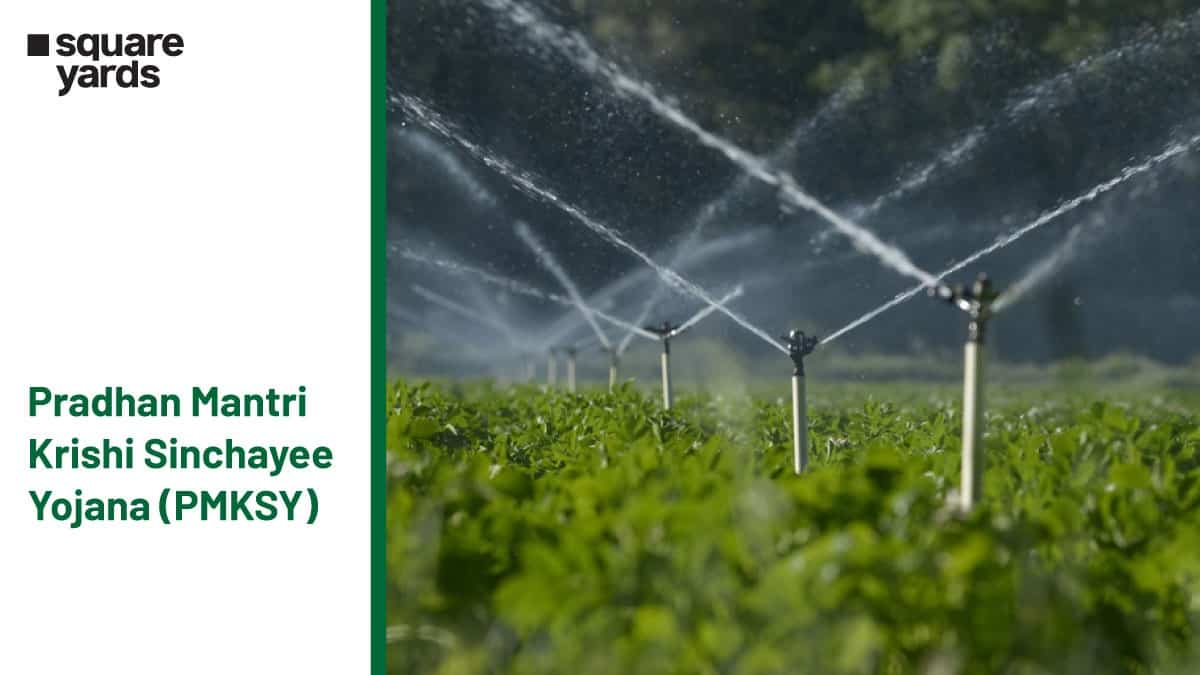The farmers and other agricultural experts have to rely on rainfall for the cultivation of farms due to dearth of water sources. This forces them to take a significant risk because there is no way of knowing when and how much rain will fall.
With the increasing risks for farmers and the water conservation irrigation system, the Indian government initiated a number of schemes. Pradhan Mantri Krishi Sinchai Yojana (PMKSY) is one of these. The scheme ensures that the irrigation facility is made available to the farmers of the country.
Scroll through the write-up to know the importance, objectives, purpose, and components of PMKSY.
Table of contents
- What is ‘Pradhan Mantri Krishi Sinchai Yojana’ Scheme?
- Objectives and Purpose of Pradhan Mantri Krishi Yojana (PMKSY)
- Who are the Beneficiaries of PMKSY Scheme?
- List of Documents Required for PMKSY Scheme
- Eligibility Criteria for PM Krishi Yojana
- Pradhan Mantri Krishi Sinchai Yojana Components
- How to Log in to The PMKSY Portal?
- How to Create a Nodal State User (New User) Under The PMKSY Portal?
- Wrapping Up
- You Might Also Like to Read
- Frequently Asked Questions (FAQs)
What is ‘Pradhan Mantri Krishi Sinchai Yojana’ Scheme?
On July 1, 2015, the Pradhan Mantri Krishi Sinachai Yojana (PMKSY Scheme) was introduced in India. The scheme was launched with the goal to bring irrigation investments in the agriculture sector at the field level. Under this scheme, end-to-end irrigation solutions, supply chains solutions, farm-level applications, and distribution networks will be given to the farmers.
The Pradhan Mantri Krishi Sinchayee Yojana is not only about the irrigation facilities in the agriculture field, but also focuses on developing constructive protective irrigation systems by capturing the rainwater at the ‘Jal Sanchan’ and ‘Jal Sanchay’ micro-level. The micro-level irrigation solution is the important element of the PM Krishi Sinchai Yojana, as it ensures the efficient use of water on the farm level.
The plan also calls for bringing together ministries, agencies, organisations, research, and financial institutions involved in water generation and recycling on a single platform to provide a comprehensive and holistic view of the entire water cycle. The objective is to make water budgeting more efficient in all industries. PMKSY's tagline is “more crop per drop.”
Objectives and Purpose of Pradhan Mantri Krishi Yojana (PMKSY)
PMKSY's main goals are to attract investments in irrigation systems at the field level, to develop and extend the cultivable area in the country, to improve ranch water usage to reduce water waste, and to increase crop per drop by applying water-saving technology and precision irrigation.
There are multiple objectives that the PMKSY scheme focuses on. These PMKSY objectives are mentioned below:
- Convergence of the field levels’ investments in irrigation (preparation for the district level and also for the sub-district if required for the plans of water use).
- Help in providing better access to water for the farm and agriculture level.
- Also helps in providing better irrigation systems to the cultivable farms under the guaranteed plan of irrigation, known as Har Khet Ko Pani.
- All the irrigation related sources, such as water sources, efficient use of water, and distribution are integrated to make the best use of water through the right practice and top-notch technologies.
- PMKSY improves on-field water usage efficiently to ensure that water is not wasted and availability is improved for both extent and duration.
- Focuses on increased use of precision irrigation and other technologies for saving water.
- Improvement in aquifer recharge along with implementing long-term methods for water conservation.
- Increment in private irrigation investments.
- Encourage the agriculture field workers to participate in various activities related to crop alignment, water conservation, water harvesting, and water management.
- PMKSY ensures the integrated development of rain-fed farms and areas with the approach of watershed management for water and soil conservation, preventing run-off, regenerating groundwater, and other similar NRM functions.
Who are the Beneficiaries of PMKSY Scheme?
Farmers are known to be the true beneficiary of the Pradhan Mantri Krishi Sinchayee Yojana. The PMKSY scheme is specifically designed for agricultural field workers. The initiative helps the farmers and other agriculture field experts to work wisely with water requirements for the farm land.
List of Documents Required for PMKSY Scheme
To participate in Krishi Sinchai Yojana, a few documents are required for submission, including:
- Aadhaar Card.
- Certificate of Caste.
- Proof of Address.
- State Domicile Certificate.
- Passport Size Photographs.
- Mobile Number.
- Bank Account Passbook.
- Papers of Agricultural Land.
- Certificate of House.
Eligibility Criteria for PM Krishi Yojana
To participate in the scheme, a participant needs to meet the following requirements:
- Farmers of any division or class are eligible for PMKSY.
- The farmers must own the land to avail maximum benefit of the scheme.
- People who belong to Self-help organisations (SHOs), groups of producer farmers, and trust cooperative societies can participate in the scheme after PMKSY registration.
- Farmers who work and cultivate on rented/leased land can also go for PMKSY registration.
- Only Indian citizens can apply for the Pradhan Mantri Krishi Sinchai Yojana.
Pradhan Mantri Krishi Sinchai Yojana Components
Farmers formerly experienced a lack of adequate irrigation facilities. Because of PMKSY’s attempts to address concerns at the grassroots level, all villages are now having the right water sources and irrigation facilities for better crop cultivation.
On October 26, 2015, the Integrated Watershed Management programme was included in the current PMKSY. The fundamental IWMP implementation activities were intact and were in accordance with the IWMP Common Guidelines 2008 (Revised 2011). Convergence with other Central and State Government schemes is still at the top of the program's priority list for maximising and sensibly using financial resources. Action has also been made to carry out Natural Resources Management activities using MGNREGA labour and to carry out certain Entry Point Activities in line with the Swachh Bharat Mission (Gramin).
The Pradhan Mantri Krishi Sinchai Yojana is an initiative of six components. Below tabulated are the six components of the scheme and its working needs:
| Components of PMKSY Scheme | Specifications |
| AIBP Programme |
|
| Har Khet Ko Paani |
|
| Per Drop More Crop-Micro Irrigation(MI) and Per Drop More Crop-Other Interventions (SWMA) |
|
| Watershed |
|
| Convergence with MGNREGA |
|
How to Log in to The PMKSY Portal?
To log in to the PMKSY portal, follow the steps mentioned below:
Step 1: Visit the official PMKSY portal.
Step 2: Click on the ‘Login’ option on the homepage.
Step 3: In the next window, enter the credentials (username, password, and captcha code) that you use to log in to your account.
Step 4: After filling in all the credentials, click on ‘Login’ to access your account.
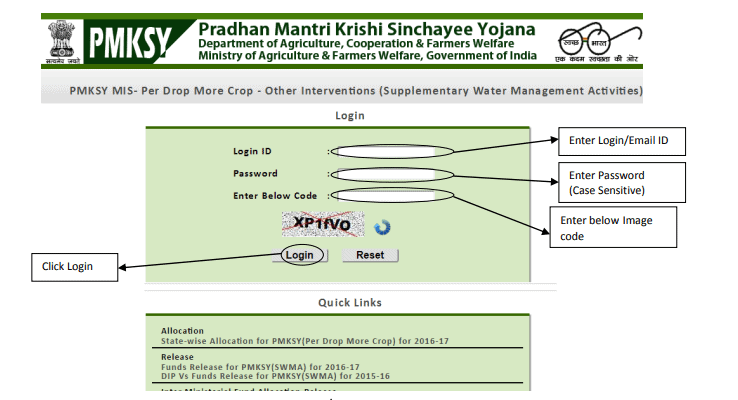
How to Create a Nodal State User (New User) Under The PMKSY Portal?
Below is the step-by-step process of creating a nodal state user under the PMKSY portal.
Step 1: Visit the official PMKSY portal. Click on the ‘Login’ option on the homepage of the portal.
Step 2: Enter the credentials and log in to your state/district account.
Step 3: After successfully logging in to the portal, place the cursor on the ‘User’ option. From the drop-down menu, click on the ‘Create User’ option.

Step 4: The portal will redirect you to the ‘New User Registration Form’. Fill in the required details, such as name, level, date of birth, etc. Click on the ‘Submit’ button after filling in all the details.
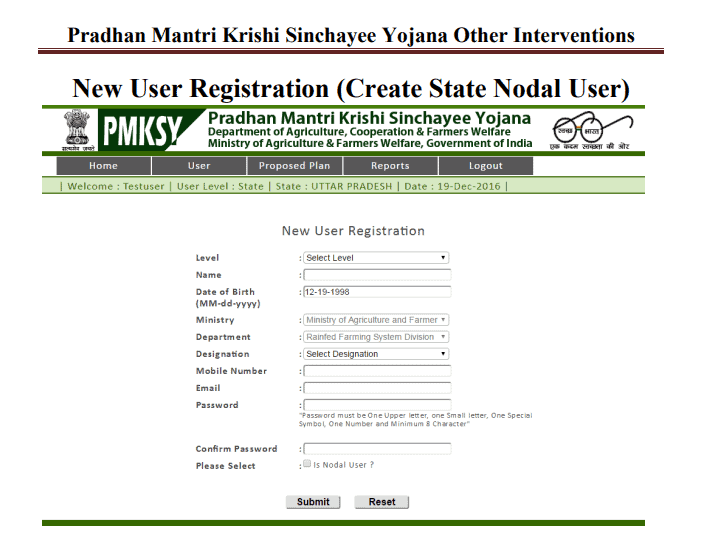
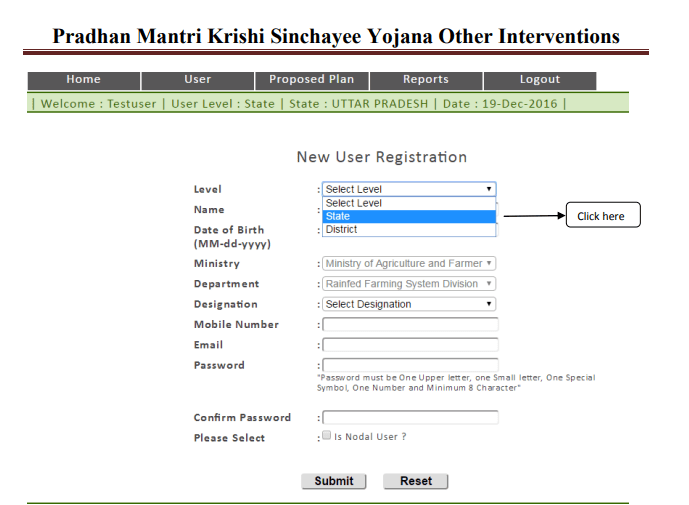
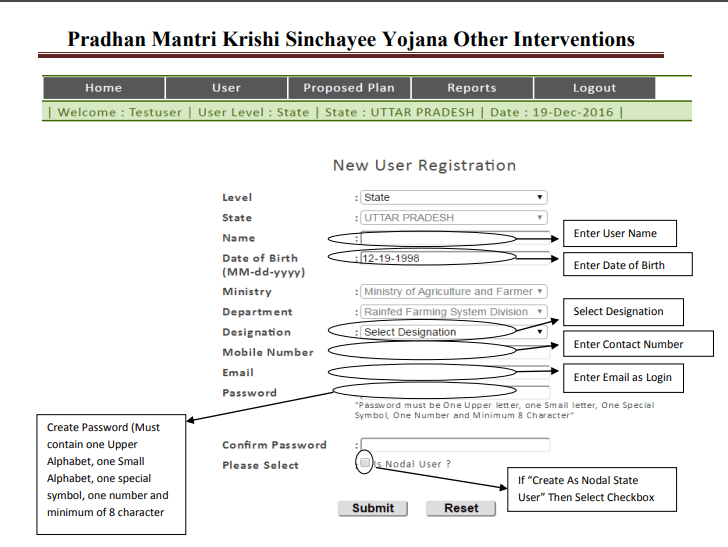
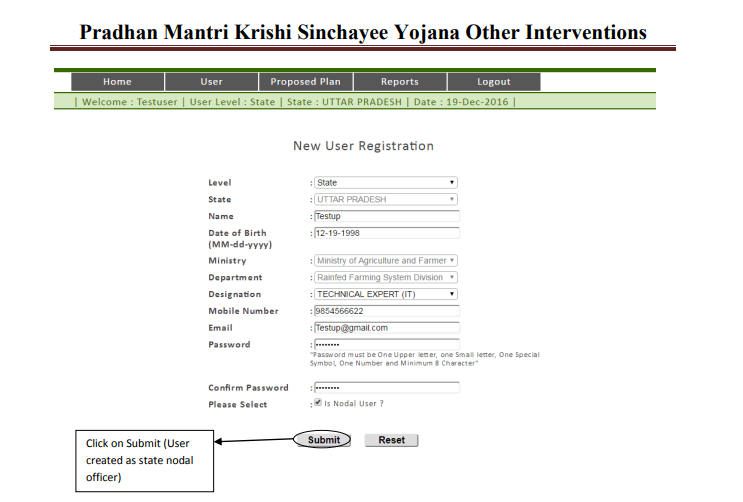
Note:
- Select ‘State’ in the level section to create a Nodal State User. The Nodal State User is given permission to create State Nodal Users, District Nodal Users, State Users, and District Users.
- The E-mail ID of the user will be the PMKSY Scheme user ID.
- The Ministry, State, and Department Textbook will already get filled in the form.
Wrapping Up
PM Sinchai Yojana is the best way for wise use of water in all farms. Alongside the availability of water, the scheme also helps the farmers to increase the cultivation of the crops. This is done by providing an end-to-end irrigation solution to the farmers under this scheme. The PM Sinchai Yojana also helps in providing a protected irrigation solution to the agricultural field of India. This will result in much desired rural wealth in the country.
You Might Also Like to Read
- Deen Dayal Upadhyaya Grameen Kaushalya Yojana
- Pradhan Mantri Jan Dhan Yojana
- Pradhan Mantri Gram Sadak Yojana
- Pradhan Mantri Suraksha Bima Yojana
- Saksham Yuva Yojana
- Pradhan Mantri Awas Yojana
- Atal Pension Yojana
- PM Kisan Samman Nidhi Yojana
- Pradhan Mantri Vaya Vandana Yojana
- Basava Vasati Yojana
- Kanya Sumangala Yojana
- Bharatmala Pariyojana
Frequently Asked Questions (FAQs)
What is the full form of PMKSY?
PMKSY refers to the Pradhan Mantri Krishi Sinchai Yojana scheme launched by the prime minister of India.
What is the launch date of Pradhan Mantri Krishi Sinchai Yojana?
The PMKSY was launched in January 2006 as a Centrally Sponsored Scheme (CSS) for the purpose of micro irrigation in the agriculture sector.
Who started the PMKSY Scheme?
The Department of Agriculture and Cooperation started the Pradhan Mantri Krishi Sinchai Yojana as a CSS to scale up the level of the National Mission of Micro Irrigation (NMMI).
What is the contact email ID for PMKSY?
To contact PMKSY, one can mail on the email ID support.pmksy-dac@gov.in.
What is the method of subsidy release to the beneficiary under the PMKSY scheme?
The farmers can apply for the PMKSY scheme via online or offline methods. The subsidy will be released for the beneficiaries through the direct benefit transfer. Also, the subsidy is limited to up to 5 hectares of land per beneficiary.
What is the GST rate applicable for Micro Irrigation Systems?
About 12% GST rate is applicable for Micro Irrigation Systems even if the subsidy is supplied separately to the beneficiary.
How to get the benefit of the PMKSY scheme?
Farmers can apply for the PMKSY scheme to get the benefit. Since the scheme is aimed to achieve convergence in agricultural irrigation and help in expanding the cultivable areas, farmers can make efficient use of irrigation water under the scheme.
What will be the role of Honourable Member of Parliament and local MLA in Pradhan Mantri Krishi Sinchai Yojana?
The Member of Parliament (MP) and the local Member of Legislative Assembly (MLA) is responsible for the implementation and execution of the scheme in that area.

